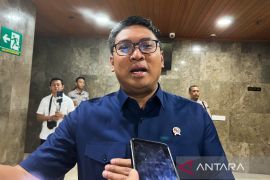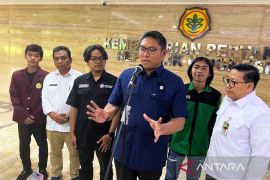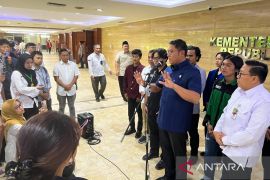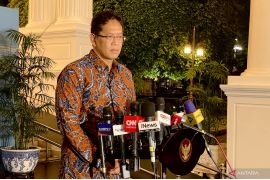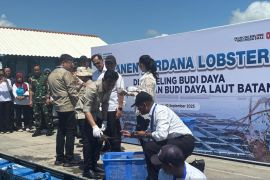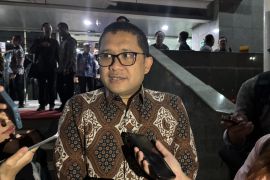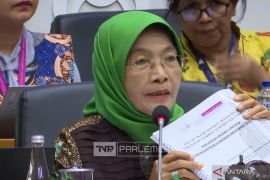The Ministry of Marine Affairs and Fisheries, Sharif C. Sutardjo, said that the tuna industry is currently facing many challenges. The productivity reduction, the size shrinkage, and the difficulty of tracking tuna population on the high seas, to name a few. Therefore, the MMAF bolsters the the sustainable fisheries development to meet those challenges. The sustainable tuna development includes the tuna reproduction, genetic, water temperature and swimming depths as well as the tuna observation from the very first time it's arrived in the port or on the boat. "The research run by the Tuna Benoa Fishery Research Institute (LP2T) is MMAF's commitment to maintain the tuna resource sustainability in Indonesia as well as to meet the world's demand of tuna," said the Minister after visiting LP2T in Mertasari, Bali, on Feb.15.
Sharif stated that in the entire Indonesian Fishery Management Zone, the exploitation status of albacore, yellow fin, bigeye, and blue fin tuna is extremely alarming with the status of fully exploited and even over-exploited, and it's only the skipjack tuna still being in the moderate status. This negative trend will eventually impact the livelihood of the fishermen and the tuna industry. "The tuna sustainability is not a responsibility of one or two nations, but it's the entire world having to take part in it. The national tuna management therefore will always be a concern of the RFMOs (Regional Fisheries Management Bodies) who has mandate to regulate the global tuna management," Mr. Sutardjo asserted.
Mr. Sutardjo continued, to maintain as well as to bolster the tuna management globally, the Indonesian Government has become a member of WCPFC (Western and Central pacific Fisheries Commission). By joining the Commission, Indonesian is currently included in three Regional Fishery Management Organizations; Indian Ocean Tuna Commission (IOTC), Commission on Conservation of Southern Blue fin Tuna (CCSBT) and Western and Central Pacific Fisheries Commission (WCPFC). "Indonesia is also subject to the international law in terms of the high seas fishing activity, including the feasibility of the vessels and the conservation and the management compliance," he re-affirmed.
The tuna research
In the meantime, the Head of the R&D of MMAF, Achmad Poernomo, explained that the tuna landings monitoring is conducted over 16 tuna processing companies based in Benoa Port. The monitoring is daily run by the LP2T's enumerators by collecting the data and information of the haul and the activity aboard. The data and information collected will then be yearly delivered to IOTC and CCSBT. "Having joined to RFMO, Indonesia thus obtains the tuna fishing quota, the tuna selling access to the international market, especially to the state members of any RFMO," Mr. Poernomo explained.
MMAF keeps conducting the observation aboard the tuna longline boats accompanied by the LP2T to collect the data and information related to the haul; the size of the fish, the fishing zone, the temperature and the fishing depths. Referring to the observation hosted by LP2T, the longline boats operating zone encompasses the Java, Bali, and Nusa Tenggara, both inside and outside the Exclusive Economic Zone. "By clinging to this research, it's expected that the tuna fishermen will take home such a significant amount of haul. They just need to set the fishing depths, and if it's matching with the temperature and the optimum depths, they'll figure out the which kind of tuna about to fish out," he stated.
Poernomo added that the MMAF's R&D is currently running the genetic research of the bigeye tuna. The research shows that the bigeye tuna can be divided into two population groups; the group sourcing from the south Indian Ocean of Java and Nusa Tenggara. The second group coming from the west Indian Ocean of Sumatera. The first group allegedly comes from the Pacific Ocean while the second group is originated from the Indian Ocean. "According to the gonadal development research, the spawning season of the Indian Ocean's bigeye tuna allegedly occurs throughout the year," he explained.
The Tuna Benoa Fishery Research Institute (LP2T) is a technical unit under the MMAF's R&D. The establishment of LP2T was originally initiated with the tuna research collaboration, particularly on the southern blue fish tuna (Thunnus maccoyii) research in the Benoa Port between Australia's CSIRO and Marine Fishery Research Institute on 1993. The partnership was proceeded on 2002 by establishing the monitoring program through the multilateral partnership project (Australia, Japan and IOTC) in three key tuna landings in Indonesia; the Fishing Port of Samudera Jakarta, National Fishery Port of Cilacap and Benoa Port.
Editor: PR Wire
Copyright © ANTARA 2014


